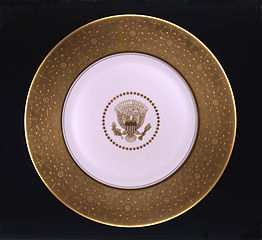
When Franklin Delano Roosevelt took the oath of office on March 4, 1933, unemployment was 25 percent; homes and farms were lost to foreclosure, and people were hungry. Hobos rode the rails looking for work. Farmers from the Great Plains migrated to California, a journey described by John Steinbeck in the Grapes of Wrath.
Incumbent President Hoover urged voters to reject Franklin Roosevelt’s strategy to use government intervention to end the Depression. Roosevelt promised them a New Deal. Hoover lost by a landslide.
Eleanor Roosevelt
Eleanor Roosevelt became an entirely new First Lady, a full political partner in her husband’s political career as well as a campaigner for social reform.
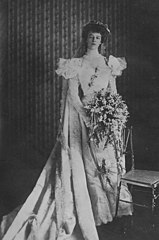
Eleanor met Franklin on a train in the summer of 1902. The couple began a secret correspondence, and became engaged the following year. Franklin’s mother opposed the match, but her son was determined to have his way. On March 17, 1905, former president Teddy Roosevelt gave the bride away.
In September 1918 while unpacking her husband’s suitcase, Eleanor discovered love letters written to her husband by Lucy Mercer, her social secretary. Franklin thought about leaving his wife to marry his new love, but was persuaded against it by his political advisor, and by his mother who told him that if he divorced his wife, she would disinherit him. From that time forward, the Roosevelt marriage was rooted in Franklin’s political career.
The partnership became firmer after Franklin contracted a paralytic disease that left him paralyzed from the waist down. Franklin’s mother thought he should retire from politics; Eleanor urged him to continue his career. From that time, Eleanor stood in for Franklin at public events, and became his eyes and ears among his colleagues and constituents. In so doing, Eleanor gained influence in the New York Democratic Party. She also became active in the Women’s Trade Union League.
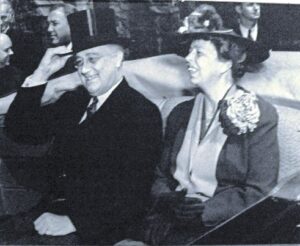
When Roosevelt became president, Eleanor was ready for the challenge. She continue her speaking agenda, donating her earnings to charity. Eleanor earned $75,000 during her first year as First Lady. Her speaking fee rose to $1000 in 1941.
As a way to help female journalists keep their jobs, Eleanor didn’t allow male reporters to cover her weekly press conferences. And, because the Gridiron Club didn’t allow women to attend the annual Gridiron Dinner, Eleanor hosted a competing event she called the Gridiron Widows.
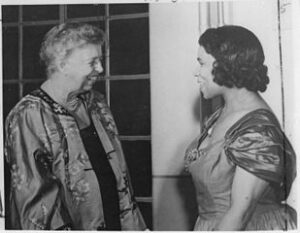
Eleanor openly supported civil rights and anti-lynching legislation. One of her more public acts was in 1936 when she arranged for Marian Anderson to sing in concert at the Lincoln Memorial after the Daughters of the American Revolution denied Anderson the use of their Constitution Hall.
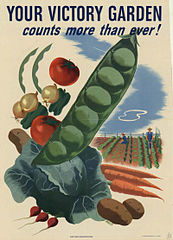
When the United States entered World War II, Eleanor threw herself into the war effort. Like Edith Wilson, she set an example of food rationing. Eleanor also embraced gas rationing, participated in air raid training (including learning how to use a gas mask), and established a Victory Garden on the South Lawn of the White House.
Eleanor ramped up her travel schedule. In 1942, she visited American servicemen in England. The following year, she flew to Australia and New Zealand as a representative of the Red Cross. When there were complaints that the First Lady wore the Red Cross uniform without receiving proper training, she dispensed with the uniform. In 1944, Eleanor visited American bases in the Caribbean Basin and Central and South America.
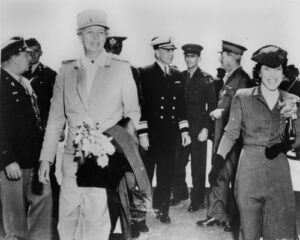
While the First Lady traveled, her daughter Anna fulfilled her duties. One unhappy result of this arrangement was when Franklin decided to take his daughter to the Yalta Conference in 1945, rather than his wife.
Neither woman was present at Warm Springs, Georgia on April 12, 1945 when Franklin died of a cerebral hemorrhage. However, Lucy Mercer Rutherfurd was in attendance.
After Franklin died, Eleanor Roosevelt continued her life of public service and was a key member of discussions resulting in the 1948 United Nations Declaration of Human Rights.
Bess Truman
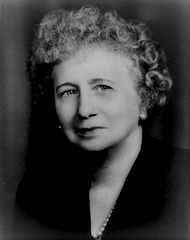
When Bess Truman became First Lady in 1945, Americans were tired of war and deprivation. Allied troops declared Victory in Europe Day on May 8, 1945. In August, American planes dropped atomic bombs on Hiroshima and Nagasaki. On September 2nd, Japan surrendered.
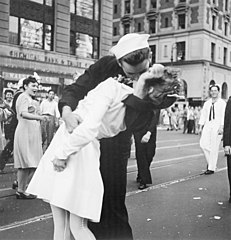
Americans were both euphoric that the war was over and apprehensive about what the postwar world would bring. They looked forward to the end of rationing and hoped for a strong economy. It was an uncertain time, a moment when many Americans wanted to turn away from social activism in favor of secure expectations. It was time for a new sort of First Lady, one who represented stability amidst uncertaintty. Bess Truman filled the bill.
Born in Independence, Missouri, Bess married a young man she’d known since the fifth grade. When Harry Truman became a Senator in 1935, she served as his advisor, speech writer and office manager. When Harry chaired the Committee of Military Affairs, he hired Bess as his office clerk.
In 1944, Franklin Roosevelt prepared to run for a fourth term as president. Looking at the possibility of a vice-presidential succession, Roosevelt’s advisors looked for a vice-presidential candidate acceptable to Democrat party leaders. They chose Truman, who became president in April 1945. Truman ran for election to his own term in 1948, embarking on a “whistle stop” campaign in which he introduced his wife as The Boss and his daughter Margaret as The Boss’s Boss.
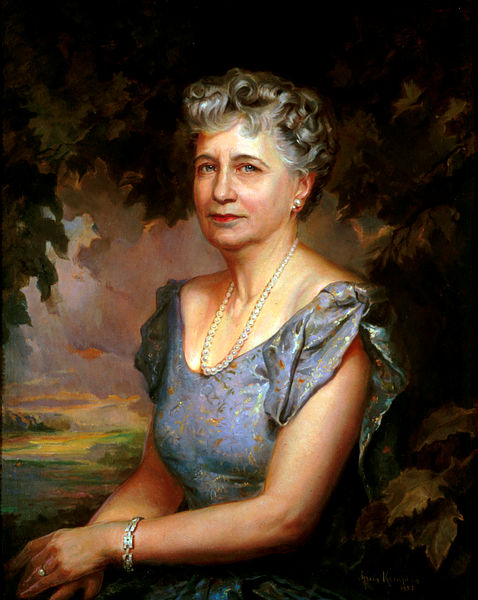
As First Lady, Bess Trumen was almost a complete opposite to Eleanor Roosevelt. She never held a press conference or granted an interview, though she would respond to written questions from the press.
Bess presided over an active social life at the White House. She revived the tradition of a “social season,” sponsoring a schedule of dinners and receptions in winter and spring to honor members of the different branches of government. The schedule of state dinners also increased. Bess planned menus of plain American food, with a particular emphasis on ham and corn dishes popular in the Midwest.
In her personal life, Bess paid a weekly visit to a hair salon to have her “poodle cut” styled, ate her supper on what she called the “porch,” also known as the White House South Portico, and hand-wrote her correspondence. Bess spent much of the summer at her home in Independence, Missouri where she cultivated her flower garden.
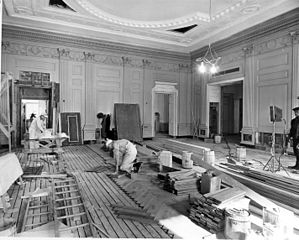
State Dining Room Under Renovation 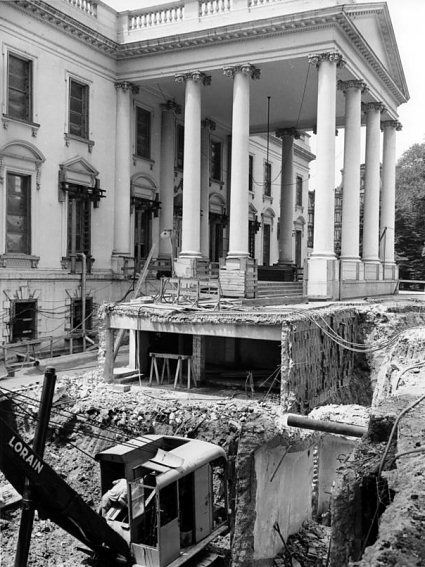
Digging the Basement During Renovations
Shortly after Truman’s re-election in 1948, it was discovered that the White House was in danger of collapse – to the extent that the Trumans had to vacate the premises while contractors went to work. Some thought it would be more cost effective to tear down the structure, but Bess thought it was important to preserve at least four of the original walls to serve as a shell for a modern mansion. When the Trumans returned to the White House in 1952, air conditioning had been installed.
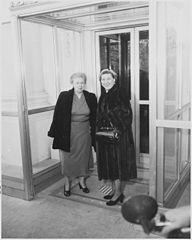
Harry Truman declined to run for re-election in 1952. The new President, Dwight D. “Ike” Eisenhower, was a retired five-star general who had commanded Allied forces in Europe. Bess invited Mamie Eisenhower to tour her new home, establishing a presidential transition custom.
Mamie Eisenhower
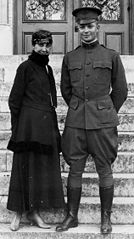
Mamie met her future husband in 1915 when he was stationed at Ft. Sam Houston for his first tour of duty. Ike later said Mamie immediately drew his attention; she was “a vivacious and attractive girl, smaller than average, saucy in the look about her face and in her whole attitude.” Mamie returned the compliment, later saying that he was “the spiffiest looking man I’d ever talked to in all my born life.” When the couple married in July 1916, Mamie began her career as an Army wife. By the time the Eisenhowers left the White House, the family had moved 28 times.
Mamie’s preference for a specific shade of pink that became known as First Lady or Mamie Pink launched a national trend for pink clothing, housewares, and bathrooms. I suppose that’s why my childhood bedroom was painted a shade of pink that I still dislike.
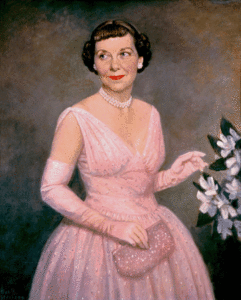
Mamie wore a notable pink gown to the 1953 inaugural balls. The peau de soie gown was embroidered with more than 2,000 rhinestones, and paired with matching gloves and a beaded purse. The New York Dress Institute named Mamie one of the best dressed women in the country, and the Mamie Look of a full-skirted dress, little hats, charm bracelets, pearls and a hairstyle that featured bangs swept the country.
Reflecting the values of most middle-aged, middle class American women, Mamie defined the role of First Lady as being the president’s wife, and Hostess of White House events.
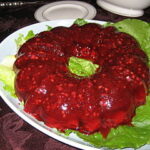
Like many American women, Mamie clipped coupons and pinched pennies. To keep costs down, Mamie scanned newspapers to see what bulk items were on sale, and encouraged the kitchen staff to use boxed cake mixes, and also to serve Jell-O.
In addition to organizing receptions and state dinners, Mamie served as Ike’s ceremonial substitute by meeting with large groups visiting the White House. During the tourist season, Mamie shook hands and waved as groups traveled through the state rooms.
On Sept 24, 1955, Ike suffered a heart attack while on a visit with Mamie’s family. While he recuperated, Mamie limited his schedule and answered his mail. In November 1957, when Ike suffered a mild stroke, Mamie insisted that Vice-President Nixon attend a state dinner in his place.
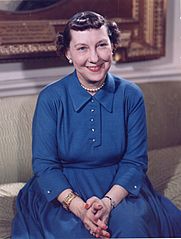
In an article Mamie wrote for Today’s Woman, Mamie advised women that “Your independence depend[s] on you…[the only way] to avoid debt…is for the husband to give his wife the paycheck and let her be responsible for it…If he sets up charge accounts and pays the bills…things are almost certain to get out of hand…” Mamie also thought married women should not pursue careers outside the home. 🧐
🧊🧊🧊
I hope you found this 5-part blog series on First Ladies from 1789-1961 interesting. I’m struck by the efforts these women made to enhance the office of First Lady, and the effect their personal preferences have had on the nation as well as the office. More insights into American First Ladies can be found in this video from The National Portrait Gallery.
Illustrations
Charger Plate, Eisenhower Presidential China.
*Mamie Eisenhower augmented the Truman Presidential China Service by purchasing 120 “charger” plates. these plates remain in front of the diner during the main meal. Other plates, such as salad plates or dinner plates, are placed on top of the charger plate.
Eleanor Roosevelt in her wedding dress, 1905.
Franklin & Eleanor Roosevelt, November 1935.
Eleanor Roosevelt & Marion Anderson in Japan, 1953.
Victory Garden Poster, 1945.
Eleanor Roosevelt with Jean Marie MacArthur in Queensland, Australia, 1943.
Bess Truman.
Victory over Japan. Photo by Victor Jorgenson, August 14, 1945.
Portrait of Bess Truman.
Northeast view of State Dining Room during White House Renovation, 1952.
Digging the Basement under the North Portico during White House Renovation, 1952.
Bess Truman with incoming First Lady Mamie Eisenhower, December 1, 1952.
Mamie & Dwight D. Eisenhower, San Antonio, 1916.
Portrait of Mamie Eisenhower.
Jello cranberry salad by Shadle
Mamie Eisenhower, 1954.
J Y Smith. “Mamie Eisenhower Dies at 82.” The Washington Post. Nov 2, 1979.
National First Ladies Library.
National Museum of American History: First Ladies.
First Ladies of the United States. National Portrait Gallery.

Sandra Wagner-Wright holds the doctoral degree in history and taught women’s and global history at the University of Hawai`i. Sandra travels for her research, most recently to Salem, Massachusetts, the setting of her new Salem Stories series. She also enjoys traveling for new experiences. Recent trips include Antarctica and a river cruise on the Rhine from Amsterdam to Basel.
Sandra particularly likes writing about strong women who make a difference. She lives in Hilo, Hawai`i with her family and writes a blog relating to history, travel, and the idiosyncrasies of life.

